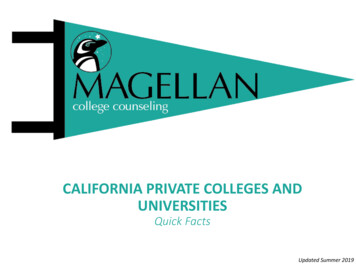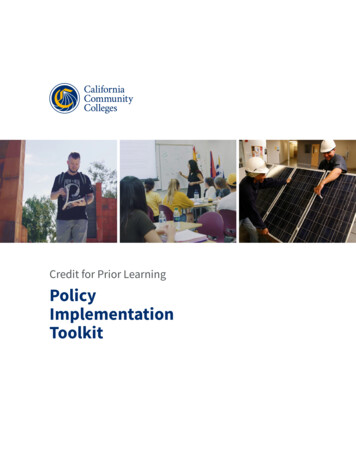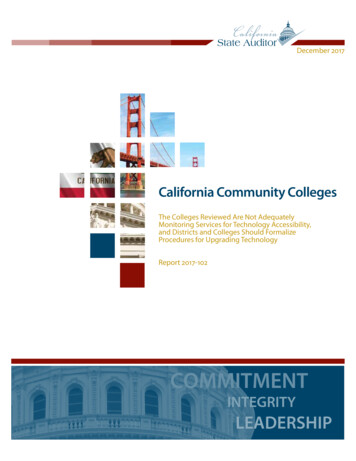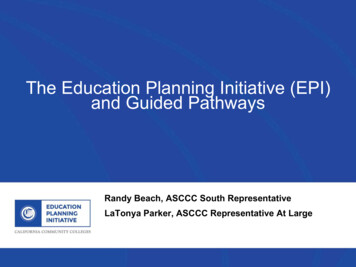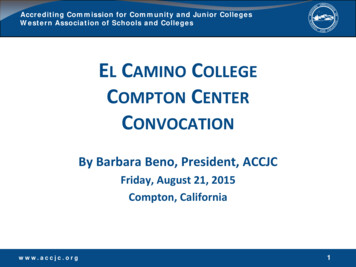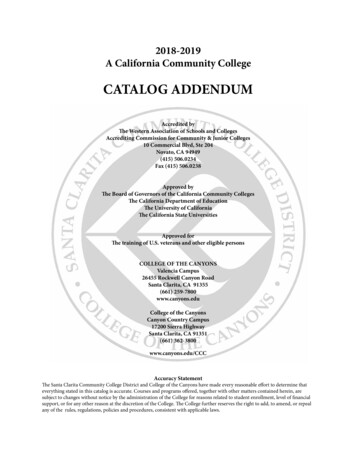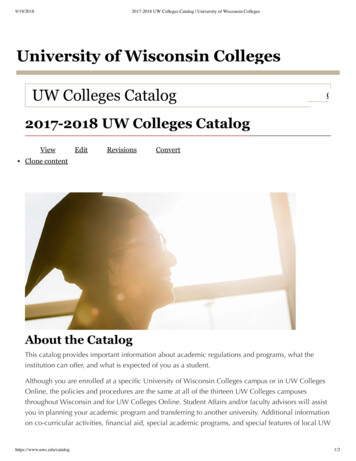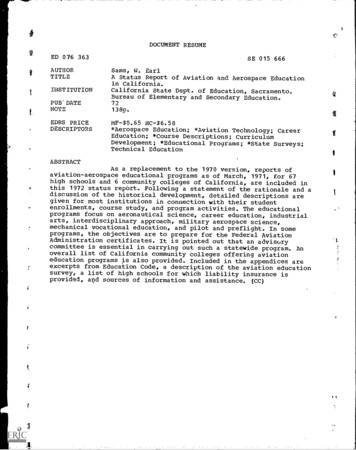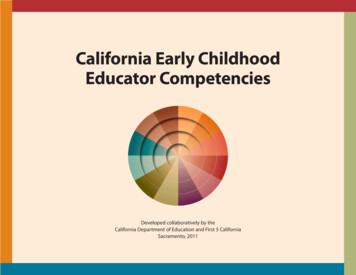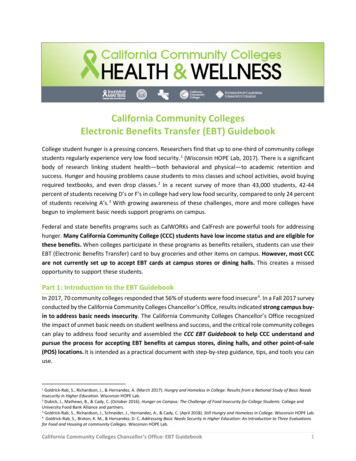
Transcription
California Community CollegesElectronic Benefits Transfer (EBT) GuidebookCollege student hunger is a pressing concern. Researchers find that up to one-third of community collegestudents regularly experience very low food security. 1 (Wisconsin HOPE Lab, 2017). There is a significantbody of research linking student health—both behavioral and physical—to academic retention andsuccess. Hunger and housing problems cause students to miss classes and school activities, avoid buyingrequired textbooks, and even drop classes. 2 In a recent survey of more than 43,000 students, 42-44percent of students receiving D’s or F’s in college had very low food security, compared to only 24 percentof students receiving A’s. 3 With growing awareness of these challenges, more and more colleges havebegun to implement basic needs support programs on campus.Federal and state benefits programs such as CalWORKs and CalFresh are powerful tools for addressinghunger. Many California Community College (CCC) students have low income status and are eligible forthese benefits. When colleges participate in these programs as benefits retailers, students can use theirEBT (Electronic Benefits Transfer) card to buy groceries and other items on campus. However, most CCCare not currently set up to accept EBT cards at campus stores or dining halls. This creates a missedopportunity to support these students.Part 1: Introduction to the EBT GuidebookIn 2017, 70 community colleges responded that 56% of students were food insecure 4. In a Fall 2017 surveyconducted by the California Community Colleges Chancellor’s Office, results indicated strong campus buyin to address basic needs insecurity. The California Community Colleges Chancellor’s Office recognizedthe impact of unmet basic needs on student wellness and success, and the critical role community collegescan play to address food security and assembled the CCC EBT Guidebook to help CCC understand andpursue the process for accepting EBT benefits at campus stores, dining halls, and other point-of-sale(POS) locations. It is intended as a practical document with step-by-step guidance, tips, and tools you canuse.1 Goldrick-Rab, S., Richardson, J., & Hernandez, A. (March 2017). Hungry and Homeless in College: Results from a National Study of Basic NeedsInsecurity in Higher Education. Wisconsin HOPE Lab.2 Dubick, J., Mathews, B., & Cady, C. (October 2016). Hunger on Campus: The Challenge of Food Insecurity for College Students. College andUniversity Food Bank Alliance and partners.3 Goldrick-Rab, S., Richardson, J., Schneider, J., Hernandez, A., & Cady, C. (April 2018). Still Hungry and Homeless in College. Wisconsin HOPE Lab.4 Goldrick-Rab, S., Broton, K. M., & Hernandez, D. C. Addressing Basic Needs Security in Higher Education: An Introduction to Three Evaluationsfor Food and Housing at community Colleges. Wisconsin HOPE Lab.California Community Colleges Chancellor’s Office: EBT Guidebook1
The EBT Guidebook was created using resources linked throughout this document. The EBT Guidebookwas also developed by the California Community College’s Chancellor’s Office using information andinsights provided by Daren Lynne, Director of SpecialProjects & Academic Support, Los Angeles City College The Guidebook focuses on helping collegesFoundation. Ms. Lynne was integral to the food apply to accept EBT benefits at POS locations.security efforts of Los Angeles Trade Technical College If you are interested in learning about(LATTC) and Los Angeles Community College District comprehensive approaches to CCC studenthunger and homelessness, visit the California(LACCD).Community Colleges Health & WellnessThe California Community Colleges Chancellor’s Office website:anticipates the EBT Guidebook will be a useful and e resource in your work to support student -needs-initiative/wellness. 5Part 2: Overview of Key ConceptsEBT, CalFresh, and SNAP are different terms that are often used interchangeably, which can be confusing.This section provides a brief overview of terms discussed in the EBT Guidebook.Electronic Benefits Transfer (EBT) is an electronic system through which statesissue benefits. Benefits programs that are issued through EBT include, but are notlimited to: CalFresh; CalWORKs; Medi-Cal/Medicaid; and Women, Infants, andChildren (WIC) Special Supplemental Nutrition Program.People who receive cash or nutrition benefits use an EBT card to pay for items at participating retailers.EBT cards look like debit cards, use a magnetic stripe and Personal Identification Number (PIN) like debitcards, and are designed to be discreet. An EBT card is used for all the programs described in this EBTGuidebook.EBT cash benefits are intended to provide financial assistance for necessities such as rent, utilities, andfood and other household essentials. People who receive EBT cash benefits can use their EBT card to payfor these items in participating stores; they can also withdraw money at ATMs. Any item that can be legallypurchased with currency can be purchased with EBT cash benefits, but some types of stores are excluded(see Tool 1 for more about eligible stores).EBT cash programs include state general assistance; refugee assistance; and Temporary Assistance forNeedy Families (TANF), known in California as CalWORKs (California Work Opportunity and Responsibilityto Kids). To receive CalWORKs benefits, a person must be pregnant or the parent of a child under 19, havelow or very low income, and meet other requirements.Although this Guidebook mainly refers to students, we wish to acknowledge that some faculty and staff also participate in these benefitsprograms. Food insecurity is a widespread issue that cuts across social and cultural categories.5California Community Colleges Chancellor’s Office: EBT Guidebook2
CalFresh is California’s implementation of SNAP, the Supplemental Nutrition Assistance Program. 6CalFresh provides monthly benefits for households with low income to pay for food, food products, andfood-producing plants or seeds. (For a list of eligible and ineligible items, see Tool 1.) CalFresh recipientsdo not need to be eligible for other financial assistance or social services programs to participate inCalFresh. CalFresh eligibility is based on household size, income, and monthly expenses. There are alsocertain eligibility requirements that are specific to students. According to GetCalFresh.org, as many as 2in 5 students are eligible for CalFresh.The Restaurant Meals Program (RMP) is a long-standing program that allows CalFresh recipients whoare homeless, disabled, or 60 years of age or older to use their CalFresh benefits to buy hot, nutritious,prepared meals. The purpose of this program is to provide reduced-cost meals to people who may nothave the tools or ability to cook food at home.The EBT Guidebook uses “benefits retailer” to describe any store, restaurant, or college that participatesin EBT cash, CalFresh, or the Restaurant Meals Program. In other words, these are retailers that are setup to accept EBT cards as payment for food or other items.Part 3: Deciding to Become a Benefits RetailerBefore your campus begins the application process for any ofthese benefits programs, it is helpful to consider why, how, andwith whom you will partner to become a benefits retailer (seeTool 2 for potential partners).With your partners, reflect on how becoming a benefits retailercomplements your college’s overall commitment to studenthealth and wellness. Your college may have an advanced studentfood security strategy already in place, or it might be justbeginning to explore this issue. Understanding the needs of yourstudents, identifying your goals, and honing your strategy fromthe beginning will help you later in the process, as you reach outto other stakeholders, decision-makers, and the community (seeTool 3 for ways to develop your strategy).Key Resource: Survey GuideCheck out the Guide to AssessingBasic Needs Insecurity in HigherEducation (2018) from The HopeCenter to learn how to use surveys toassess basic needs insecurity on yourcampus. Campus-level data can helpyou develop a focused argument forbecoming a benefits retailer.The list below provides steps that may help clarify yourplanning process. However, it’s also important not to losemomentum at this stage. Ideally, you will balance your broad,campus-level perspective with practical steps toward becominga benefits retailer.SNAP was formerly known as “food stamps,” but this term should not be used, because it is outdated and stigmatizing. It is mentioned hereonly to provide a frame of reference for readers.6California Community Colleges Chancellor’s Office: EBT Guidebook3
Planning Steps: Research the current state of benefits at your college. For example, does your campus alreadyaccept EBT cash? Are efforts underway at the district level to roll-out the Restaurant MealsProgram? Bring the right partners to the table (see Tool 2).Achieve buy-in among decision-makers (see Tool 3 for strategies and data sources). On manycampuses, you will need support from the Office of the Vice President of Student Services.Other key decision-makers may include administrative services and dining management. Consider how cash or food benefits fit into your college’s strategic plan, commitment to studenthealth and wellness, and/or food security approach. Why should your campus become abenefits provider? Do a preliminary assessment of the resources (people, time, training, etc.) your campus willneed to pursue the application or implementation process. This EBT Guidebook can help youwith this assessment. Decide which program(s) you will pursue. For example, will you begin with becoming an EBTcash provider, or will you pursue EBT cash and the Restaurant Meals Program simultaneously? Work with partners, as applicable, to establish agreed-upon next steps and realistic timelines.Part 4: Accepting EBT CashThe simplest way for colleges to begin accepting benefits is by becoming an EBT cash retailer. This allowsstudents to buy food and other items on campus with their EBT card using their cash benefits, such asCalWORKs.Retailers do not need special state or federal government approval to begin accepting EBT cash. This isone reason why EBT cash is often the easiest route for schools.For official information, visit the California EBT Project Office website and review the pages formerchants.Steps to Become an EBT Cash Retailer Determine whether you have the right equipment in place in your cafeteria and/or stores. EBTcards require the use of a PIN, so your point-of-sale (POS) equipment must have a PIN pad. If needed, purchase and install POS terminals with PIN pads. If needed, work with your credit card vendor to update your agreements.Contact your credit card vendor to ensure your agreements allow for processing of EBTtransactions. You and your processor must be compliant with the Quest Operating rulesCalifornia Community Colleges Chancellor’s Office: EBT Guidebook4
Contact your third-party debit transaction processor. Ask them to have the California EBT IIN(Issuer Identification Number: 507719) added to the debit card transaction set of your POSequipment.o If the processor asks for a federal or state government number, they are referring to theUSDA Food and Nutrition Service (FNS) number. You do not need an FNS number,because you are planning to accept EBT cash benefits, not CalFresh/food benefits. Tellthem to fill the FNS number field with seven zeroes (0000000). At the locations where you will accept EBT cash, train staff in advance so that they are preparedto answer students’ questions, as needed (see Key Resource: Training Guide, below). Forexample, you may want to let staff know that:o Your location now accepts EBT cash, which is not the same as SNAP/CalFresh.o It’s important not to stigmatize or single out students who pay with EBT cards; staffshould treat students paying with EBT like anyone else using a debit card.o Students must have their EBT card with them, and their PIN, in order to use EBT aspayment.o Students may use EBT cash for food and any other item that can be legally purchasedwith cash (see Tool 1 for eligible and ineligible purchases).o If you provide cash back for debit card purchases, you can also provide cash back for EBTcash purchases. Test your ability to accept EBT cash as payment. For example, inform a small group of interestedstudents that they can now use EBT cash, and test for one month. Market your college as an EBT cash retailer to your whole campus (see Part 7 for moreinformation).Part 5: Applying for the Restaurant Meals ProgramSeveral counties participate in the Restaurant Meals Program (RMP), which allows people who arehomeless, elderly, or disabled to use their CalFresh benefits to buy meals at restaurants, cafeterias, andother prepared-food vendors. To participate in the RMP, a CCC must be located in a participating countyand must have a qualifying food facility on campus. 7Recent state laws have been passed to try to get more higher education institutions to participate in theRestaurant Meals Program. 8 As of 2017, if a college is located in an RMP county and the college operatesa qualifying food facility on campus, the college is required to apply to become an approved RMP vendor.If a college is located in a RMP county, but all food facilities on campus are operated by outside vendors,the college is only required to provide information to their vendors about the RMP and how to apply.For official information and to apply, visit the California Department of Social Services RestaurantMeals Program website.AB 1894, signed into law in September 2018, allows any California State University (CSU) to participate in RMP, even if the CSU is not locatedin a participating county. This law does not apply to CCC.8 AB 1747, effective January 1, 2017. For more information, review All County Letter No. 16-112.7California Community Colleges Chancellor’s Office: EBT Guidebook5
(For a list of CCC campuses located in RMP counties, visit New Tools to Reduce College Campus Hunger:AB 1747 [Weber] Implementation Fact Sheet.)Steps to Apply for RMP9 Check to make sure your county participates in the RMP: Alameda, Los Angeles, Orange,Riverside, Sacramento, San Diego, San Francisco, San Luis Obispo, Santa Clara, or Santa Cruz. Make sure your campus has qualifying food facilities. To qualify, food facilities must: sellprepared food that is intended to be consumed on-site, provide a lower-cost meal option, havemore than 50 percent of total sales in food, and not be exclusively a carry-out facility (such as aconcession stand). 9 Confirm with campus stakeholders that an RMP application is not already in progress. Contact county social services to inquire about their process for becoming an RMP provider.Most of the county-specific RMP webpages, linked above, provide a phone number or emailaddress for the social services division or staff member to contact. Your county will be able towork with you to submit your application, and they may have an enrollment packet for you.o If applicable, discuss with your county social services department whether your collegeshould apply for RMP independently, with other colleges or vendors, or as a district. If any concerns about the RMP arise after discussing it with the county, examine these issueswith your key stakeholders or decision-makers. Determine whether these issues are resolvable,more information is needed, or your strategy needs to shift.o For example, after meeting with the county, LATTC had concerns that there would be alarge number of people who were not students coming to campus regularly for the RMP.They explored how the county advertises RMP-participating institutions, and found thatthe information was listed in a lengthy document on the county website. LATTCdetermined that it was unlikely that many people who were not students would find thisinformation and come to campus just for the RMP. If you will be applying with multiple campuses, your district, or vendor(s), complete Memorandaof Understanding (MOUs) with these other parties.Consider whether your campus will apply independently, with other colleges in your district,with your contracting food vendor(s), or at the district level.o For example, LATTC started the RMP process as a single campus. Their Culinary Arts andProfessional Baking program provides fresh food daily to their cafeteria and campusrestaurant, so they had qualifying food facilities. They then added two other LACCDcampuses that also had culinary instruction programs providing food services for thecampus cafeteria, and, finally, they added six other LACCD campuses with food servicesprovided by a contracted vendor.For more information, review All County Letter No. 16-112.California Community Colleges Chancellor’s Office: EBT Guidebook6
Sign an MOU with the county. The MOU will spell out the county’s responsibilities and yourcollege’s responsibilities, such as providing low-cost meals and publicizing the program amongstudents. Because CCC are state entities rather than nonprofit or for-profit restaurants, your college ordistrict’s legal department may advise or request changes to the county’s standard RMP MOU. Complete the USDA Supplemental Nutritional Assistance Program Application for Meal Services(FNS 252-2) and submit it to the county. Application items include:o Copy of a government identification card and Social Security card for owners or officers.Note that you will need to provide identification information for an individualresponsible person at your college; your county may be able to advise whom thatperson should be (for example, at LATTC, this was their Vice President of AdministrativeServices).o Current Business License/Seller Permito Current Public Health Operating Permit The county may have additional documentation that they require from all applicants or fromhigher education institutions in particular.o For example, LATTC’s application included supplemental items: LACCD Combined Cost of Goods Sold Report for the previous year Campus maps showing the cafeteria locations Healthier Options Checklist demonstrating that there are healthy (whole grain, fruitand vegetable) and reduced-price options available Sample Menu of Healthy Options, Monday through Thursday for breakfast andlunch When ready, the county will submit your application to the USDA. Contact your POS vendor to integrate EBT into your existing payment processing machines, orsign up for flat-rate processing with a third-party EBT vendor (e.g., www.goebt.com). This stepcan only be completed once you have your FNS number. Advertise the RMP on campus. Post signs or decals in your participating locations. The countywill also list your college as an RMP vendor on its website and/or outreach materials. See Part 7for more outreach strategies.If your application is approved, the USDA will send you an FNS number. Send a copy of yourapproval to the county.Highlighted College: Los Angeles Community College DistrictLos Angeles Trade Technical College, Los Angeles City College, and Los Angeles Valley College haveworked to successfully become an EBT cash, RMP, and CalFresh retailer over the last four years, andthese activities represent just one component of the college’s comprehensive, ongoing studentsupport efforts. Other current strategies include: Weekly pop-up food pantries conducted on campus in partnership with a faith-basedorganization, feeding 1,000-2,500 students in a single day (advertised through social media onTwitter handle @LATTCcares and Instagram #LATTCCares, #LACCCares)California Community Colleges Chancellor’s Office: EBT Guidebook7
Creating a “core list” of food items with Office Depot to receive reduced-price snacks forstudentsWorking with contracted vendors (Pacific Dining) to provide breakfast and lunch support tostudents during midterms and finals, such as a breakfast burrito, peanut butter sandwich,yogurtSpeaking at the California Community Colleges Chancellor’s Office 2018 Basic Needs Summit was apivotal experience for Daren Lynne, who is integral to LACCD’s food security efforts:“The summit provided a place for like-minded, like-tasked, individuals to gather and discuss theseissues. I now had a core group on could call on for advice, and found that I had information othersneeded so that they did not duplicate the effort. I want to stress that these summits or conferencesare key to making sure the colleges are successful. Here at LACCD, we now realize we need to worktogether collaboratively to save time and resources; to identify core goals and strategies; and toprovide a uniform solution, which can then be added to or subtracted from to meet the individualcampus’s need/goals/resources.”Part 6: Applying for CalFreshA college can also apply to become a CalFresh retailer, which allows students to use their CalFreshbenefits on campus to buy groceries. However, it is less common for CCC to become CalFresh providersthan EBT cash retailers, due to the application criteria.For official application requirements, visit the USDA website for SNAP Retail Food Stores andFarmers Markets.California Community Colleges Chancellor’s Office: EBT Guidebook8
Steps to Apply as a CalFresh Retailer Determine whether your campus store(s) is/areeligible to accept CalFresh benefits. Stores must meet one of two criteria to be eligible.o Criterion A: maintain a continuous stock of acertain variety and quantity of staple foods,including perishable foods. Staple foods arenon-prepared foods in these four categories:fruits and vegetables; meat, poultry or fish;dairy products; and breads or cereals. Storesmust stock at least three units of three staplevarieties in each of these four categories,including at least three units of oneperishable food in at least two categories.o Criterion B: have more than fifty percent oftotal gross retail sales from the sale of staplefoods. (This criterion often applies to storesthat sell one type of staple food, such asbutchers.)o There are additional requirements for thesecategories. Visit SNAP: Is My Store Eligible?for up-to-date requirements and examples.o Staple food guidelines can be found here:https://fns-Key Resource: Training GuideThe USDA provides a 20-page SNAPTraining Guide for Retailers (Spanishversion) with detailed informationabout SNAP program rules. CalFreshretailers are strongly encouraged toreview this guide. It covers topics suchas respecting people who pay with EBT;processing EBT at POS; handlingcoupons, bag or bottle fees, and taxes;and NAP-Staple-Foods.pdfo Colleges must have the required product mix in their stores before they submit theapplication. Register for a USDA eAuthentication account. Return to “How Do I Apply to Accept Benefits?” to login and begin your application. You willneed:o Basic information (name of applicant, date when your location opened, location name,location address, etc.)o Ownership informationo Actual or estimated sales for the past year across various item types (e.g., staple foods, hotand cold prepared foods, nonfood items like soap or paper)o Number of varieties of each staple food category (e.g., number of kinds of fruits andvegetables)o Information about how many units you stock of each variety of staple foodso Information about how many perishable foods you stock in each staple food categoryo Supplemental information about your location’s open days, equipment, and banko Colleges do not need to fill out section 14 on the FNS-252 SNAP Retailer Application form You will need to submit supporting documentation such as:California Community Colleges Chancellor’s Office: EBT Guidebook9
The individual that submits the application isSNAP retailer applications andrequired to send a copy of their validsupporting documentation should beCalifornia ID.sent to the following address:o As with the Restaurant Meals Program, youSNAP Retailer Service Center USDA –must submit this information for an individualFood and Nutrition Serviceperson with responsibility for these servicesPO BOX 7228Falls Church, VA 22040at your campus. If they leave theorganization, you must update yourinformation on your USDA account.o Copy of your business tax returnOnce approved, you will receive a SNAP retailers license, training manual, and IT/set-upspecifications. Visit the SNAP Retailers Store Training Information page to view the trainingguide and watch a training video.As with EBT cash and RMP, you will need to work with your existing payment processingvendor or a third-party EBT vendor to set your POS to accept CalFresh.Within 30 days of your accepted application, a USDA Inspector will conduct an unannouncedaudit of your location. The Inspector will confirm that you have the type, variety, and quantityof staple foods that you claimed in your application.There are many strategies and resources available to market your college as a CalFresh retailer.See Part 7 for suggestions.o Highlighted College: Humboldt State University (HSU)Finding that 19% of their students reported having CalFresh benefits, HSU embarked on theapplication process to become a CalFresh retailer. They successfully achieved this process,conducting over 11,000 EBT transactions amounting to more than 100,000 in sales in 2016-2017.HSU Oh SNAP!, the college’s student-driven food program, helped support outreach to studentsand reduce stigma around EBT.For more information about how HSU became a CalFresh vendor, including the challenges theyfaced, view their presentation from the 2018 CSU Basic Needs Initiative Conference: EBTImplementation: Humboldt State UniversityPart 7: Marketing Your College as a Benefits RetailerOnce you are ready to begin accepting EBT payments, you will want to share the news with your wholecampus community! This section focuses on outreach and engagement strategies.You will also want to ensure that key personnel are able to speak knowledgeably with students aboutEBT cash, CalFresh, and/or the RMP. For example, consider the different messaging and training needsof different stakeholders. Sales or service staff members will need to be able to ring up purchases at POSCalifornia Community Colleges Chancellor’s Office: EBT Guidebook10
using EBT cards. They will also need to know, forexample, whether the campus store accepts bothEBT cash and CalFresh. On the other hand,student services staff and counselors will benefitfrom knowing how to prescreen students forCalFresh. Finally, leadership staff will want to beable to articulate how being an EBT retailer fitsinto the campus’s broader approach to addressingstudents’ basic needs. Reflecting on what yourvarious campus stakeholders need to know willhelp you develop clear, consistent messaging.Sample Marketing and Outreach StrategiesKey Resource: Students.GetCalFresh.orgGetCalFresh.org is an official State ofCalifornia CalFresh outreach partner. Theyare one of several online portals toconnecting California residents to benefitsprograms. They are included here as anexample of effective student marketing.Their Students page includes engaginggraphics (e.g., emojis), streamlinedinformation, and student-friendly language.For example, under the heading “this onegoes out to,” sample taglines include“Anyone who couldn’t find free pizza at aclub meeting night” and “Anyone whosefriend wouldn’t swipe them into the dininghall.” Does your campus have a broadermarketing strategy or umbrella campaignfor student wellness or food securityactivities on campus? If so, work withthem to leverage their communicationchannels and/or branding. Use student-friendly visuals and languageto engage and welcome students.Incorporate recognizable imagery, likeyour school mascot. Post information about EBT at POS and inall relevant stores or dining halls. Thishelps students know they can use theirEBT card without having to ask. Post flyers at other key locations thatstudents experiencing food insecuritymay visit, such as the campus foodpantry, financial aid office, library, andathletic center. Make sure relevantcampus departments and partners (seeTool 2) are aware of this new paymentoption. Include information about EBT on yourcampus website, such as on the pages fordining services, campus stores, CalFreshoutreach, CalWORKs, etc. Send email announcements to all faculty and staff to let them know that EBT cards can now beused on campus, at which locations, and for what benefits (cash or CalFresh).California Community Colleges Chancellor’s Office: EBT Guidebook11
In your messaging to employees, be mindful of the fact that food insecurity doesn’t only impactstudents. Some faculty or staff members may also participate in CalFresh, CalWORKs, oranother benefits program. When possible, include brief information about: how to apply for benefits (see “CalFreshOutreach,” below); and how students who are not eligible for benefits can receive help withfood insecurity (for example, include a link to your campus food pantry). Avoid stigmatizing terms such as “needy,” “poor,” “impoverished,” or “food stamps.”o Neutral language is preferable: “cash or food benefits,” “cash or nutritional assistance,”etc.o Use people-first language whenever possible, such as “students who receive CalFreshbenefits,” “student-parents who participate in CalWORKs,” “people who receive cash orfood benefits.”Key Resource: CalFresh BiteableCalFresh OutreachMany students who are eligible for benefits do not apply.They may not be aware that they are qualified, they may beconfused or intimidated by the application process, or theymay be deterred by social stigma. A 2016 study at onecampus found that only 20% of students who were eligiblefor CalFresh actually participated in the program. 10The CalFresh Outreach program is an important part of theState of California’s efforts to e
California Community Colleges Chancellor's Office: EBT Guidebook 1 California Community Colleges Electronic Benefits Transfer (EBT) Guidebook College student hunger is a pressing concern. Researchers find that up to one -third of community college students regularly experience very low food security.1 (Wisconsin HOPE Lab, 2017). There is a .
